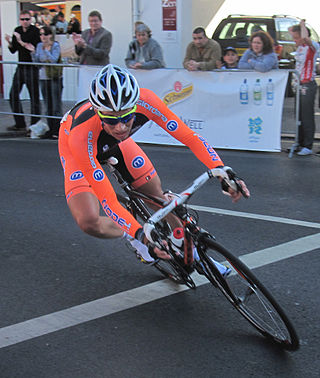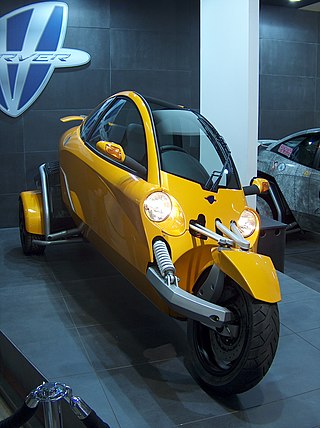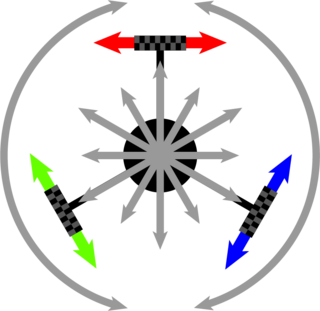
Steering is the control of the direction of motion or the components that enable its control. Steering is achieved through various arrangements, among them ailerons for airplanes, rudders for boats, cylic tilting of rotors for helicopters, and many more.
A traction control system (TCS), is typically a secondary function of the electronic stability control (ESC) on production motor vehicles, designed to prevent loss of traction of the driven road wheels. TCS is activated when throttle input and engine power and torque transfer are mismatched to the road surface conditions.

Suspension is the system of tires, tire air, springs, shock absorbers and linkages that connects a vehicle to its wheels and allows relative motion between the two. Suspension systems must support both road holding/handling and ride quality, which are at odds with each other. The tuning of suspensions involves finding the right compromise. It is important for the suspension to keep the road wheel in contact with the road surface as much as possible, because all the road or ground forces acting on the vehicle do so through the contact patches of the tires. The suspension also protects the vehicle itself and any cargo or luggage from damage and wear. The design of front and rear suspension of a car may be different.

A four-wheel drive, also called 4×4 or 4WD, is a two-axled vehicle drivetrain capable of providing torque to all of its wheels simultaneously. It may be full-time or on-demand, and is typically linked via a transfer case providing an additional output drive shaft and, in many instances, additional gear ranges.

A limited-slip differential (LSD) is a type of differential gear train that allows its two output shafts to rotate at different speeds but limits the maximum difference between the two shafts. Limited-slip differentials are often known by the generic trademark Positraction, a brand name owned by General Motors and originally used for its Chevrolet branded vehicles.

An anti-roll bar is an automobile suspension part that helps reduce the body roll of a vehicle during fast cornering or over road irregularities. It links opposite front or rear wheels to a torsion spring using short lever arms for anchors. This increases the suspension's roll stiffness—its resistance to roll in turns.

A tilting three-wheeler, tilting trike, leaning trike, or even just tilter, is a three-wheeled vehicle and usually a narrow-track vehicle whose body and or wheels tilt in the direction of a turn. Such vehicles can corner without rolling over despite having a narrow axle track because they can balance some or all of the roll moment caused by centripetal acceleration with an opposite roll moment caused by gravity, as bicycles and motorcycles do. This also reduces the lateral acceleration experienced by the rider, which some find more comfortable than the alternative. The narrow profile can result in reduced aerodynamic drag and increased fuel efficiency. These types of vehicles have also been described as "man-wide vehicles" (MWV).

A drive wheel is a wheel of a motor vehicle that transmits force, transforming torque into tractive force from the tires to the road, causing the vehicle to move. The powertrain delivers enough torque to the wheel to overcome stationary forces, resulting in the vehicle moving forwards or backwards.

The Jeep Hurricane is a bespoke custom concept vehicle that was unveiled at the 2005 North American International Auto Show in Detroit by American automaker Jeep. Its principal exterior designer was Aaron Pizzuti. The concept went on to win IDEA Silver Award, a Popular Science "Best of what's new" award, and an Autoweek Editor's Choice award in the "Most Fun" category.

Fishtailing is a vehicle handling problem which occurs when the rear wheels lose traction, resulting in oversteer. This can be caused by low-friction surfaces. Rear-drive vehicles with sufficient power can induce this loss of traction on any surface, which is called power-oversteer.

A Mecanum wheel is an omnidirectional wheel design for a land-based vehicle to move in any direction. It is sometimes called the Swedish wheel or Ilon wheel after its inventor, Bengt Erland Ilon (1923–2008), who conceived of the concept while working as an engineer with the Swedish company Mecanum AB, and patented it in the United States on November 13, 1972.

Bicycle and motorcycle dynamics is the science of the motion of bicycles and motorcycles and their components, due to the forces acting on them. Dynamics falls under a branch of physics known as classical mechanics. Bike motions of interest include balancing, steering, braking, accelerating, suspension activation, and vibration. The study of these motions began in the late 19th century and continues today.

The Renault Mégane Renault Sport is a series of high-performance hatchback models based on the Renault Mégane, produced since 2004 by the high-performance subsidiary company Renault Sport for its parent company Alpine, a subsidiary of Renault. The Mégane RS won awards such as "Best hot hatch" from What car? (2010–2014), "Highest placed non-supercar" in Evo's annual Car of the Year test 2011 and "Best hot hatch" from Top Gear.

Omni wheels or poly wheels, similar to Mecanum wheels, are wheels with small discs around the circumference which are perpendicular to the turning direction. The effect is that the wheel can be driven with full force, but will also slide laterally with great ease. These wheels are often employed in holonomic drive systems.
An idler-wheel is a wheel which serves only to transmit rotation from one shaft to another, in applications where it is undesirable to connect them directly. For example, connecting a motor to the platter of a phonograph, or the crankshaft-to-camshaft gear train of an automobile.

A rear-engine, front-wheel-drive layout is one in which the engine is between or behind the rear wheels, and drives the front wheels via a driveshaft, the complete reverse of a conventional front-engine, rear-wheel-drive vehicle layout.

A zero-turn riding lawn mower is a standard riding lawn mower with a turning radius that is effectively zero when the two drive wheels rotate in opposite direction, like a tank turning in place.
The VK 45.01 (P), also informally known as Tiger (P) or Porsche Tiger, was a heavy tank prototype designed by Porsche in Germany. With a dual engine gasoline-electric drive that was complex and requiring significant amounts of copper, it lost out to its Henschel competitor on trials, it was not selected for mass production and the Henschel design was produced as the Tiger I. Most of the already produced chassis were rebuilt as Elefant Panzerjäger tank destroyers.

A Killough platform is a three-wheel drive system that uses traditional wheels to achieve omni-directional movement without the use of omni-directional wheels. Designed by Stephen Killough, after which the platform is named, with help from Francois Pin, wanted to achieve omni-directional movement without using the complicated six motor arrangement required to achieve a controllable three caster wheel system. He first looked into solutions by other inventors that used rollers on the rims larger wheels but considered them flawed in some critical way. This led to the Killough system:
Picture a round platform with three motors underneath, each governing the motion of two wheels that look like miniature balloon tires. The wheels in each pair are mounted in a cage at right angles to each other; the motor can rotate the cage so that one wheel or the other is touching the ground at any one time. By configuring the three pairs of wheels to allow the same type of motion found in three pivoting casters, and by changing the relative speeds of the motors, Killough can make his robotic platform rotate, follow a straight or curved path, and even rotate while moving forward.
















